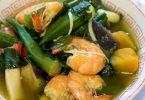Pinakbet or Pakbet is a vegetable dish made with a mixture of native vegetables and often flavored with bagoong (fermented shrimp or fish paste). Pakbet traces its origins to the northern regions of the Philippines, particularly in the Ilocos provinces. It was traditionally prepared by the indigenous Ilocano people and remains a staple dish in the Ilocos region. The name “pinakbet” is believed to be derived from the Ilocano word “pinakebbet“, which means “shrunk” or “shriveled.” This term refers to the cooking process, where the vegetables are often sautéed until they shrink or become somewhat wilted.
The dish’s history is closely tied to the agricultural practices and culinary traditions of the Ilocano people. As an agrarian society, they cultivated a variety of native vegetables, such as bitter melon (ampalaya), eggplant (talong), string beans (sitaw), okra, squash, and various leafy greens. These vegetables were typically grown in the region and were readily available for consumption.
The use of bagoong, a fermented shrimp or fish paste, is a fundamental component of pinakbet. It adds a distinctive umami flavor to the dish. Bagoong was a common condiment in Filipino cuisine, and it was used to enhance the taste of many traditional dishes.
Today, pinakbet remains a popular and beloved Filipino dish. It’s also enjoyed by many Filipinos and people of Filipino descent around the world. While traditional recipes are still widely followed, modern variations may include other ingredients like pork, shrimp, or even chilies for added flavor. Despite its variations, pinakbet remains a symbol of Filipino resourcefulness, adaptability, and the use of indigenous vegetables. It has a strong connection to the cultural heritage and culinary identity of the Philippines.
How to cook Pinakbet
Additional Information
Read more about Pinakbet or Pakbet and other popular Filipino dishes. Check out the links below to learn to discover more!







